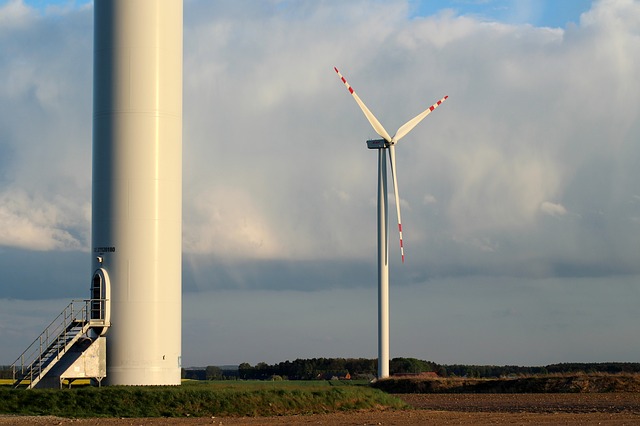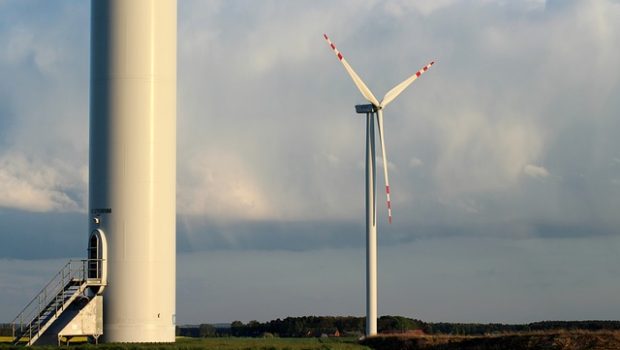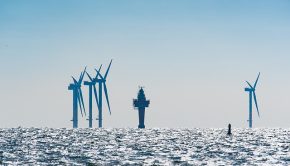Wind is America’s largest renewable energy provider and top choice for utility-scale, says AWEA –
Wind is America’s largest renewable energy provider and top choice for utility-scale, says AWEA –

In 2019, wind power emerged as America’s top choice for renewable
energy after 9.1 GW of total capacity was installed, representing 39% of new
utility-scale additions. With said additions, operating wind capacity in the
U.S. now stands at approximately 105 GW. Wind energy supplied over 7% of the
nation’s electricity in 2019.
The Wind Powers America Annual Report 2019 released
by the American Wind Energy Association (AWEA) revealed that U.S. wind industry
not only topped 100 GW, but also employed 120,000 Americans, invested $14
billion in projects and provided $1.6 billion in local payments last year.
“U.S.
wind power has grown significantly over the past decade, as consumers across
the country increasingly turn to wind to provide affordable, reliable, and
clean electricity for their communities,” AWEA CEO Tom Kiernan said.
“Years
of hard work culminated with wind power becoming America’s largest renewable
energy provider in 2019, with a 50-state footprint of job creation and economic
development. Wind’s near-record project pipeline indicates this growth will
continue for years to come. While we are now working to mitigate the
significant disruptions from COVID-19, we know that we will meet these
challenges with strong industry momentum.”
Wind power capacity and generation end the decade at new heights
The
U.S. wind industry experienced its third strongest year in 2019, as project
developers invested nearly $14 billion in new wind projects totaling 9,137 MW.
This captured 39% of new additions. Total operating wind power capacity
increased 9.6% to 105,591 MW with 60,000 wind turbines now operational.
This
growth resulted in American tripling its wind power capacity, as wind power now
represents 30% of utility-scale power plant installations over the past ten
years.
Texas
and Iowa led the country in wind power additions, both states installed
individual record amounts of wind power for a single year. South Dakota had the
largest growth in 2019, increasing installed wind capacity by 50% after
installing 506 MW.
In
total, wind project developers delivered 55 projects in 19 states during 2019.
Wind
energy also generated over 7% of the country’s electricity, which is equal to
the electricity demands of California and New Jersey combined. At the state
level, wind produced more than 20% of the electricity in Iowa, Kansas, Maine,
North Dakota, Oklahoma and South Dakota.
In
Iowa and Kansas, wind is the single largest source of electricity, as both
states generated over 40% of their electricity from wind power last year.
Large-scale wind power
helps support grid reliability. In the Southwest Power Pool, wind met nearly
28% of total electricity demand in 2019 and represented nearly 70% of power
generation at points in time. These records showcase the ability of grid
operators to integrate large amounts of wind power. The wind industry is poised
for continued expansion in the future.
Another 44 GW of capacity
is being developed and those projects will represent $62 billion in investment
in the U.S. economy.
In addition to these
onshore wind development, many US states up and down the East Coast are looking
to add offshore wind capacity. In total they are aiming to develop 25 GW of
offshore capacity by 2035, with 16 GW announced in 2019 alone.
Wind energy powering rural economies
The U.S. wind industry
directly employs 120,000 Americans, across all 50 states. Wind turbine
technicians represent the second fastest growing career in the country,
according to the U.S. Bureau of Labor Statistics.
Veterans also find wind
jobs at a rate of 61% higher than the average U.S. industry. Texas leads the
way for wind power jobs, with 25,000 wind works employed. Iowa, Illinois,
Colorado and Indiana round out the top five states for wind energy employment.
Over 530 U.S. factories
across 43 states have built wind turbine components, employing 26,000
Americans; many of which are in rural or small towns.
Wind energy brings
unmatched investment to rural America, where 99% of wind projects are located.
In 2019 alone, wind projects paid over $900 million in state and local taxes.
These payments help improve school systems, fix roads and fund emergency
services, according to AWEA. In total, wind projects are delivering $1.6
billion annually to state and local communities.
Wind energy reduced U.S.
carbon emissions by 198 metric tons in 2019, equivalent of taking 42 million
cars off the road. Last year, wind projects also saved 103 billion gallons of
water and helped address air pollution.
“Communities
across the nation, especially rural communities, are experiencing first-hand
the economic benefits that wind power delivers,” Kiernan said. “The wind
industry’s rapid and continued growth has meant more family-sustaining jobs,
more local manufacturing, more opportunities for veterans, and more support for
farming communities, all while providing reliable, low-cost, and zero-carbon
electricity for millions of Americans.”
Strong demand from utilities and corporate buyers continues
Demand for wind energy set a record in
2019, as utilities and corporate buyers announced over 8,700 MW of new wind
power purchase agreements (PPAs). Utilities signed up for 5,000 MW of wind
energy and corporate buyers signed PPAs for 3,460 MW of wind energy. That
strong interest was driven mostly by economics. Wind costs have fallen by 70%
over the past decade, making it the most affordable source of renewable energy.
Private industry accounted for 40% of
PPAs signed in 2019. Walmart and AT&T were the two top corporate buyers.
Additionally, fourteen new companies entered the wind power PPA market in 2019,
including such diverse industries as Baker Hughes, Estee Lauder and McDonald’s.
Industry working hard to address COVID-19 challenges
COVID-19 (coronavirus) is affecting
the U.S. wind industry as it is all other industries in the world. AWEA said the
industry is focused on ensuring the safety of the wind workforce and protecting
American jobs and economic investments.
According to AWEA, COVID-19 is putting
an estimated 25 GW of wind projects at risk and $35 billion in investments,
which includes the potential loss of $8 billion to rural communities in many
forms, as well as the loss of over 35,000 jobs such as wind turbine technicians,
construction workers and factory workers.
These losses will be felt the most
strongly in rural communities and the industry will continue working with
Congress and other renewable energy leaders to address the challenges of
COVID-19 to ensure continuous project development.
“Affordable,
reliable energy is not a luxury – it’s a necessity,” Kiernan said. “It provides
the foundation and powers the infrastructure of our great country, ensuring its
operations and functionality can continue without interruption on the road to
recovery, and the wind energy workforce is working hard to keep the lights on
during this trying time.”








